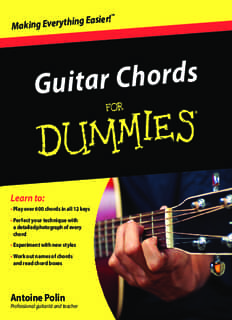‘Guitar Chords For Dummies Beginners’ PDF Quick download link is given at the bottom of this article. You can see the PDF demo, size of the PDF, page numbers, and direct download Free PDF of ‘Guitar Chords For Dummies Beginners’ using the download button.
Guitar Chords For Dummies PDF Free Download

STRUMMING THE CHORDS
Single notes are picked. Chords are strummed. A chord is a group of three or more notes… on different strings… played at the same time.
The right hand movement, while strumming chords, will vary according to the number of strings you wish to play. Do not try to rest, or brace your hand against the guitar top.
Try to achieve a loose, relaxed stroke. Slant the pick slightly to allow it to glide across the strings. Strum slowly and softly until the best possible tone is produced.
HOW TO TUNE THE GUITAR
without a pitchpipe or piano. Tuning is a difficult procedure for the beginner. It takes a great deal of practice. If you study the guitar with a teacher. tuning will be no problem. Your teacher will guide you.
Turn pegs slowly to avoid string breakage. Make sure you turn the proper peg. Turn the peg of the E string (the 6th, thick est string)
until you get a low pitched tone (as close to the low E sound as you can remember). Then do the following: Press 5th fret of 6th string. Pluck it to get pitch of 5th string (A). Press 5th fret of 5th string.
Pluck it to get pitch of 4th string (D).nLines and spaces can be referred to by number or by letter name.
The first seven letters of the alphabet are used to name the notes, thus we have A, B, C, D, E. F. G. F Leger Lines The staff can be extended by additional lines added above or below.
repeated many.. times.. depending on the musical range needed to write a composition. The alphabet will occur on alternate lines and spaces in the staff.
Being a Canny Reader
Under each chord name you’ll find a summary of the relevant notes (for example, Root = C; maj 3rd = E; 5th = G).
In some cases, you can find notes carrying double flats or double sharps, which could throw you somewhat.
Take the chord C diminished 7 (Cdim7) on page 40, where you read: dim 7th = B b b.
This isn’t a mistake: in effect, a B with two flats diminishes that note twice by one semitone. On the guitar, that would bring you to A.
However, if you were to count as you did earlier, you’d find that the 7th of C is B and that A is the sixth! In current
parlance among musicians, the tendency would be not to mention the double flats and sharps. In the case of our
example, you’d no longer say that the diminished 7th of C is A. However, according to the rules of theory, it is indeed a
B double flat.
In order to avoid having too many double flats/sharps and making the reading of this book too confusing, some sharp or flat keys (for example, C #/D b) are referred to either as sharp or flat: for example, B b involves far fewer double flats than A # has double sharps, which means that it is easier to read.
You’ll notice that we’ve removed the perfect fifth from certain chords. Take C79 for example (page 43) which consists of the notes C, E, B b, D.
In theory, this chord also includes the perfect fifth (G), but the guitar is made in such a way that it would be extremely difficult, and indeed occasionally impossible, to position the fingers to be able to play all these notes.
Where perfect, the fifth doesn’t contribute any essential colour to the chord, unlike the root/third/seventh. It would, therefore, be possible to remove it, if need be, so as to be able to place other notes in the chord.
Some chords might discourage you at first either because they require a particular position of the fingers or greater pressure. Don’t throw in the towel! The chords contained in this book are all achievable and fun to play. With a little effort, you’ll soon find that you have no further difficulty in playing them.
You’ll notice that if you follow the logic of this book, some chords are missing, such as the Ø9 or M7 11 chords and
more. Although occurring less frequently, these missing chords do still exist.
Moreover, they refer to some very specific and quite complex rules of theory so we didn’t consider it necessary to include them in this book.
It is (unfortunately!) possible to play some notes and chords on the guitar without really ‘understanding’ what you’re doing, rather like a robot. Whether you use this book as a dictionary or as a method, we recommend that you listen carefully to each chord that you work on. Try to sing the notes of the chord, to recognise its colours.
This enables you to progress much more quickly and your pleasure in making music will only be the greater for it.
Lastly, we can’t stress enough how important it is to devise and try out your own chords. There’s no such thing as a ‘bad’ chord. It’s all a question of taste, context and artistic preference.
| Writer | Antoine Polin |
| Language | English |
| Pages | 387 |
| Pdf Size | 17.8 MB |
| Category | Music |
Related PDFs
Guide Book PDF To Learn Guitar
Alfred’s Essentials Of Music Theory PDF
Guitar Chords For Dummies Book Pdf Free Download
